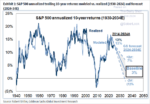Last week will be remembered for several things. First, the Bank of Japan lifted its interest rate target for the first time in 17 years and formally ended its Yield Curve Control and ceased buying ETFs. The yen sold off and the dollar approach the 2022 and 2023 cap slightly below JPY152. Japanese officials have used the language that has signaled heightened risk of intervention in the past. Second, the Swiss National Bank became the first G10 central bank to cut rates. Its low inflation and soft growth impulses provided a conducive backdrop, and there may be some tactical advantage in cutting before others to minimize the risk of the franc strengthening. Third, the PBOC relented and allowed the dollar to rise above the CNY7.20 cap that has held it back this year. The near-term risk may extend toward CNY7.25 and possible CNY7.30. Fourth, the central bank of Mexico delivered its first rate cut. The 25 bp move contrasts with Brazil and Colombia's 50 bp cuts last week and underscores the caution at Banxico.
Finally, the median projection for Federal Reserve officials maintained the three cuts for the year, while the forecast for growth was raised, the unemployment forecast shaved, and the headline PCE deflator, the measure that is targeted, was left unchanged at 2.4%. The dollar initially sold off hard on what seemed like a dovish hold but recovered to trade at new highs for the week ahead of the weekend. The week ahead is lighter in terms of events and data, and shorter for many due to the long Easter holiday. The dollar finished last week on a firm note and the momentum indicators are not over-extended. Further gains seem likely over the next few days, even if unevenly distributed before consolidating in the latter part of the week ahead.
United States: US consumption is holding up better than retail sales suggest. January and February combined showed retail sales falling by 0.5%. Personal consumption expenditures are more comprehensive, the median forecast in Bloomberg's survey is for a 0.5% increase in February after a 0.2% rise in January. To be sure, the US consumer is pulling back but the shopping is continuing even as a slower pace. Recall that PCE rose by 1.6% in January 2023 and by 0.4% in February. Income rose by 1% in January, flattered by the cost-of-living adjustment for social security and a surge in dividend payments. Personal income rose by an average of 0.4% for the last three years. It is likely to slow this year. The median forecast in Bloomberg's survey is for a 0.3% increase in February, which would match the average of H2 23.
Market participants and policymakers may be more interested in the PCE deflator. Yet, the new information in the deflator is minimal. The CPI and PPI anticipate the PCE deflator. The variance from expectations is considerably less with the deflators than the CPI and PPI. And based on the CPI and PPI, the median forecast in Bloomberg's survey calls for a 0.4% and 0.3% rise in the headline and core PCE deflators, respectively. Given the base effect, such increases would leave the year-over-year pace steady at 2.4% for the headline deflator and 2.8% for the core. Assuming the headline deflator rose 0.4%, it would mean the six-month annualized increase was about 2.4%. down from 3.2% in H1 23. A 0.3% rise in the core deflator would translate to a 2.86% annualized rate, down from nearly 4% in H1 23.
The Dollar Index set a new high for the month ahead of the weekend near 104.50. There is little to prevent a turn to the Q1 high set in mid-February slightly below 105.00. The momentum indicators have turned higher, and the five-day moving average has crossed back above the 20-day moving average for the first time since late February. We suspect the Dollar Index could rise toward 106.00 ahead of the next jobs data (April 5). The early projections suggest another solid report with around 200k new jobs.
Japan: As the US CPI (and PPI) provide a robust gauge of the PCE deflator, and the preliminary eurozone CPI does an excellent job of anticipating the final reading, Tokyo's CPI is a useful proxy of the national figures, which are reported with a few weeks lag. Tokyo's CPI peaked at 4.4% in January 2023. The national CPI peaked the same month at 4.3%. At the end of the last year, Tokyo's CPI was at 2.4% and the national CPI was at 2.6%. In February, Tokyo's CPI was at 2.6% and the national rate was 2.9%. Measured inflation in Japan is expected to rise further in April, when the government subsidies to for household consumption end. The core rate, which excludes fresh food, is the measure the BOJ targets. Tokyo's core CPI was at 2.1% at the end of last year, while the national core was at 2.3%. The base effect took Tokyo's core CPI to 2.5% in February from 1.8% in January. It is expected to ease to 2.2% in March. The national core CPI was 2.8% in February after a 2.0% reading in January. The BOJ will update its projections next month, but its current forecast is for the core CPI to fall to 2.4% in the fiscal year that begins next week and 1.8% in the following fiscal year, which one must acknowledge is not independent of what the BOJ does.
Japan will also report February employment, retail sales, industrial production and housing starts. Japanese employment figures rarely elicit a market response, and the insight offered by the retail sales report has already been reported by household spending. Recall that Japan has already reported that February household spending fell a dramatic 2.1% (a 6.3% year-over-year decline, the most in three years). Industrial production tumbled by 6.7% in January. The earthquake that struck on January 1 and the safety scandal at Daihatsu were the main culprits. The issue now is the strength of the recovery. Industry surveys by METI suggest output may rise by almost 5% in February and 2.0% in March.
The dollar's eight-day rally against the yen ended before the weekend with a modestly lower close after reaching a new high near JPY151.85. Still, in the first 12 weeks of the year, the dollar has risen in all but two. The one-way market and higher volatility (three-month implied volatility surged from near a two-year low around 7.6% at the start of last week to almost 8.6% before the weekend, coupled with the word cues from the Minister of Finance after the BOJ hike, raises the risk of intervention. The low since the FOMC meeting is around JPY150.25. The JPY152 area capped the greenback in 2022, 2023, and so far, this year. A move above there would target the JPY155 area, though the 1990 high was closer to JPY160.
China: Industrial profits for January-February will be reported. The picture often depicted of China being the factory of the world and eating everyone's lunch contrasts with slump in industrial profits, which have been falling on a year-over-year basis every month beginning July 2022. Indeed, going back to 2019, industrial profits have been falling except for October 2020-June 2022. Yet, at the same time, the correlation with industrial profits and equities (CSI 300) is weak. China will also report its final estimate for Q4 23 current account balance. The initial estimate was $55.2 bln, which was the smallest since the contraction in Q1 20 and puts last year's surplus at $264.2 bln down from a little more than $400 bln in 2022. The 2022 surplus was about 2.2% of GDP and it looks to have fallen to about 1.5% of GDP last year. The IMF projects 1.4% this year and 1.1% next year. China's current account surplus is reported about a third of the size of its trade surplus. China reported a $823.2 bln trade surplus last year.
Through formal and informal means, the CNY7.20 level capped the dollar this year. But the pressure proved too much and Chinese officials relented and the dollar jumped to almost CNY7.23 ahead of the weekend. The dollar's surge of a little more than 0.4% was the largest gain since January 2. Like the yen, the yuan has fallen in all but two weeks here in Q1 24. It is difficult to know Beijing's pain threshold, but we suspect near-term potential extends toward CNY7.25 and possibly CNY7.30.
Eurozone: It is a quiet week for Europe, given the holiday that thins activity from the middle of the week through next Monday. The economic diary features the European Commission business and consumer surveys and M3 money supply. The takeaway from the surveys will likely be that industrial and services confidence remains in the trough but are no longer falling. Consumer confidence has gone nowhere since the middle of last year. M3 was contracting in the July through November last year but has turned higher in recent months. Still, growth is anemic and credit impulses are weak.
The euro slumped to almost $1.08 before the weekend. It recorded its lowest level since March 1. It practically met the (61.8%) retracement of the rally from the Q1 low (mid-February, ~$1.0695). The momentum indicators are trending lower, and the five-day moving average has fallen below the 20-day moving average for the first time in a month. A break of $1.08 targets the $1.0760 area initially, but the risk extends back to the mid-February low, and maybe $1.06.
United Kingdom: The light economic schedule features another look at Q4 GDP, which on the initial estimate contracted by 0.3% after a 0.1% contraction in Q3 24. The BOE uses two consecutive quarters of a decline in economic activity as its definition of a recession. Still, central bank officials do not seem too alarmed, noting the downturn was shallow, and that the UK economy already appears to be returning to growth. Sterling reached $1.28 in the buying frenzy after the FOMC meeting, but it reversed lows and fell below $1.26 before the weekend. It found support near $1.2575, the lowest level since February 16. The low for the year was set earlier in February near $1.2520. Momentum indicators are falling, and the five-day moving average pushed below the 20-day moving average for the first time since late February. Sterling pierced the lower Bollinger Band and the 200-day moving average (~$1.2590-5) but settled slightly higher. A break of $1.2570 could signal another half-of-a-cent drop, but risk may extend toward $1.2465.
Canada: After contracting by 0.5% in Q3 24, the Canadian economy bounced back in Q4, expanding by 1%. Consumption actually slowed in Q4, but government spending jumped. It has shrunk by 1.9% in Q3 and rose by 1.2% in Q4. Capex fell in both Q3 and Q4 23. Fourth quarter growth was also supported by stronger exports and fall in imports. Canada reports its monthly GDP for January. It likely grew by 0.1%-0.2%, making a small down payment for Q1 24 growth around 0.5%. The US dollar held support near CAD1.3450 in the sell-off after the FOMC meeting and rebounded to almost CAD1.3590 ahead of the weekend. Canada's soft CPI report earlier last week helped lift the greenback to a marginal new high for the year near CAD1.3615. and a marginal new high was set in the waning hours of last week’s activity. The band of resistance extends to around CAD1.3625. A push above there targets the CAD1.3700 area.
Australia: Australia reports February CPI. Price pressures have been trending lower in Australia, but the central bank, as we saw last week, is not yet persuaded that inflation is on a sustainable path toward its target. Still, the monthly CPI (the RBA still puts more weight on the quarterly report) peaked at 8.4% at the end 2022 and fell to 3.4% by the end of last year, where it still was in January. Australia will also announce its retail sales for February. Recall that retails sales plunged by 2.1% in December and then recovered by 1.1% in January. A smaller gain is likely in February. The Australian dollar was turned lower after jumping to $0.6635 in the post-FOMC frenzy. It fell to $0.6510 before the weekend. Last week's low as set on Tuesday a little lower (~$0.6505). It is holding above the trendline drawn off the mid-February and early March lows. It comes in near $0.6505 at the start of the new week and finishes the week (and month) closer to $0.6515. A break could signal a test on the year's low near $0.6450 set in mid-February, and possibly closer to $0.6400.
Mexico: Mexico's trade balance shows strong seasonal factors. It has deteriorated without fail in Januarys since 2012 and has improved in Februarys since 2007. Mexico's imports from China are emerging as a campaign issue for Trump. The USMCA agreement, which was signed by Trump, had a higher domestic content requirement. Some American observers suspect Mexico is not enforcing it. Some reports have emphasized Chinese exports to Mexico are mostly semifinished goods that are assembled in Mexico before consumed at home or exported. Last year, the US recorded a $152 bln trade deficit with Mexico.
The central bank initiated an easing cycle last week, cutting the overnight rate target to 11.0% from 11.25%. The cautious language around the cut and the (small) upward revision of its inflation forecast (3.6% year-end from 3.5%) gave the move an aura of hawkishness. The carry (and taking into account the low volatility) is still attractive. The greenback surged to almost MXN16.95, a two-week high early last week and finished the week near MXN16.7650. The low for Q1 was set on March 14 a little above MXN16.6460 and the multi-year low set last July was closer to MXN16.6260. Still, it looks like a consolidative phase has begun, maybe between MXN16.67 and MXN16.85.
Tags: Featured,macro,newsletter





















